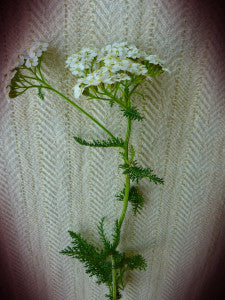Yarrow - A Fragrant Herb with a Practical Side


With leaves shaped like little feathers and a white crown of flowers, yarrow is packed with practical uses from stopping blood flow to causing a nosebleed! Intrigued? Let's take a closer look.
An Unforgettable Fragrance
Yarrow is an herb I remember from my childhood. We would travel to “the mountains” for vacations and its chrysanthemum-like fragrance was always drifting in the country breezes to greet us. I used to pick the flowers and just enjoy the smell on my hands, having no idea then that I could’ve used the same plant for the many boo-boos I would inevitably incur.
Some Colorful Folklore and Nicknames 

Despite its colorful folk history of being used by Achilles in battles to staunch the blood flow of wounds to his soldiers (hence it’s Latin name, Achillea millefolium and one of its common names, staunchweed)and being an ingredient used in making an extremely intoxicating beer in the middle ages, yarrow is an herb with a future in any survivalist’s herbal medicine stash. It has a list of additional titles as long as its history: Milfoil. Old Man's Pepper, Soldier's Woundwort, Knight's Milfoil, Herbe Militaris, Thousand Weed, Nosebleed, Carpenter's Weed, Bloodwort, Staunchweed, Sanguinary, Devil's Nettle, Devil's Plaything, Bad Man's Plaything, Yarroway, Field Hops.
Serious Abilities
Most notable and tested among its properties are its diaphoretic abilities: when the aerial parts are collected and boiled into a tea, this infusion will get you sweating out toxins at the onset of a fever or any type of flu. It is also antiseptic, so it can help cleanse out a urinary tract infection. I’ve read a number of articles 
touting its helpfulness in battling sinusitis by drying the sinuses, acting as an anti-inflammatory and easing pain.. You can also drink the tea as a digestive aid where it stimulates the gallbladder’s release of bile to improve digestion or to tone your blood vessels if you bruise easily or suffer from varicose veins. Yarrow is also commonly used for its blood-clotting, antimicrobial action on wounds. The leaves and stems can be applied directly on cuts or other bleeding wounds, where it will also reduce swelling and kill bacteria. Perhaps the history with Achilles is true… It has salacylic acid in it – like aspirin- so it is no surprise that if you have a toothache and chew on yarrow, the pain will subside. It has a bitter aftertaste, but that is bearable considering the alternative toothache. You can rub the leaves on the temples to alleviate a headache or onto insect bites or nettle stings to alleviate pain and itching. Also toting anti-inflammatory properties, yarrow has been used in the bath with great relief by those suffering from incisions after birth or with hemorrhoids.

touting its helpfulness in battling sinusitis by drying the sinuses, acting as an anti-inflammatory and easing pain.. You can also drink the tea as a digestive aid where it stimulates the gallbladder’s release of bile to improve digestion or to tone your blood vessels if you bruise easily or suffer from varicose veins. Yarrow is also commonly used for its blood-clotting, antimicrobial action on wounds. The leaves and stems can be applied directly on cuts or other bleeding wounds, where it will also reduce swelling and kill bacteria. Perhaps the history with Achilles is true… It has salacylic acid in it – like aspirin- so it is no surprise that if you have a toothache and chew on yarrow, the pain will subside. It has a bitter aftertaste, but that is bearable considering the alternative toothache. You can rub the leaves on the temples to alleviate a headache or onto insect bites or nettle stings to alleviate pain and itching. Also toting anti-inflammatory properties, yarrow has been used in the bath with great relief by those suffering from incisions after birth or with hemorrhoids.
Use to Cause a Nosebleed?
One of yarrow’s names, Nosebleed, had me wondering if it healed nosebleeds. I discovered that in olden times, people would roll up the leaves, insert them into the nose to cause a nosebleed as a way to alleviate a headache! Hmmm…. I found this ironic in relation to its blood-clotting properties! 
Harvesting Yarrow So when do you pick yarrow? Anytime it’s in flower, usually between June through September in temperate zones of the world. All of the aerial parts are helpful, so you just cut off the stalk and hang it to dry. Then, after it’s dry, separate the flowers from the leaves and stems for different uses, and store in airtight jars. (A tea for external applications uses just the dried flower . You can use this tea as a facial toner for acne and as a conditioning hair rinse. If you weren’t going to use the flowers this way, you could just store all the aerial parts together.)

Harvesting Yarrow So when do you pick yarrow? Anytime it’s in flower, usually between June through September in temperate zones of the world. All of the aerial parts are helpful, so you just cut off the stalk and hang it to dry. Then, after it’s dry, separate the flowers from the leaves and stems for different uses, and store in airtight jars. (A tea for external applications uses just the dried flower . You can use this tea as a facial toner for acne and as a conditioning hair rinse. If you weren’t going to use the flowers this way, you could just store all the aerial parts together.)
A Caution I’ve read that yarrow should be avoided during pregnancy and will cause an allergic reaction to those sensitive to the aster family of plants. Other than that, Enjoy




Leave a comment